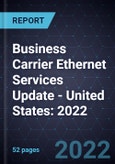Slowing Revenue Growth Rates Attributed to Pricing Compression and Market Maturity
In this report, the publisher focuses on leading service providers of comprehensive business carrier Ethernet services in the US market. This market continues to experience negative Ethernet revenue growth rates primarily due to price compression and market maturity. The report delivers market forecasts for business carrier Ethernet services from 2022 to 2026.
The publisher defines business carrier Ethernet services as services sold by providers to enterprises or businesses, which include Ethernet services in all layers (1, 2, and 3) sold under different names, including transparent or native LAN, gigabit Ethernet (GigE), metro Ethernet, Ethernet private line (EPL), EVP line (EVPL), and virtual private LAN service (VPLS). This study includes copper, hybrid fiber coaxial (HFC), synchronous optical network (SONET), dense wavelength division multiplexing (DWDM), layer 2 Ethernet switches, and MPLS Ethernet services.
The study includes an in-depth analysis of the key trends impacting the US business carrier (retail) Ethernet services market, including growth drivers, growth restraints, market revenue forecasts, and port forecasts. The revenues are not broken down by service configurations (E-Line and E-LAN) in this report. The analysis is further segmented by transport distance (metro and long haul) and service type (dedicated or port-based services and switched or VLAN-aware services).
The publisher uses the Metro Ethernet Form (MEF) definition for carrier Ethernet services. MEF, an industry consortium of network, cloud, and technology providers, has documented numerous technical requirements to build and manage feature-rich business class Ethernet services over any infrastructure and drive the widespread availability of Ethernet services.








